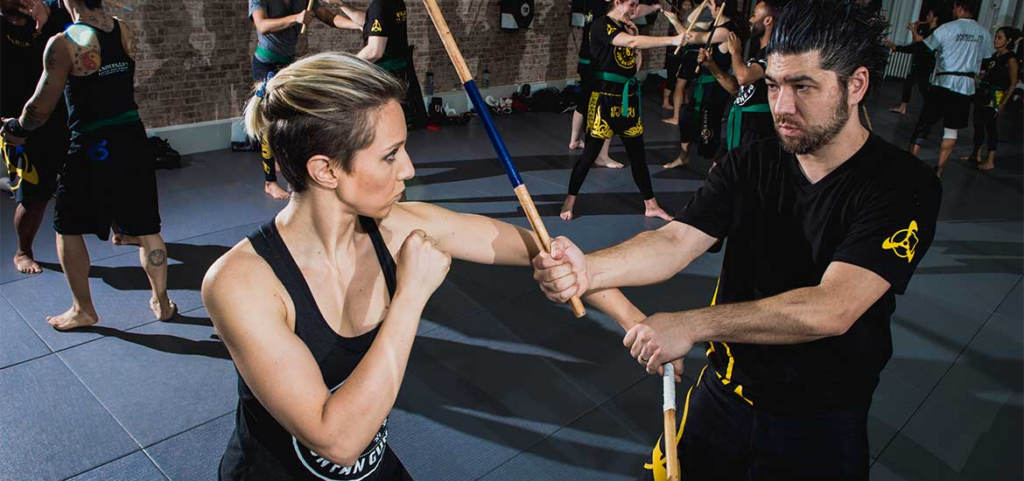There are many incredible martial arts out there from all corners of the world. One of the most fascinating is kali, which comes from the Philippines. Also known as eskrima or arnis, this fast and fluid weapons-based art form is a highly effective fighting method.
But what exactly is kali, is it great for self-defense, and should you be learning it? These are all questions I’m going to answer here. By the end, you’ll know all the key information you need about kali. Let’s get started!
Table of Contents
What is Kali?
Kali is a martial art that goes by a few names, as it’s also known as arnis or eskrima/escrima. They all refer to a catch-all term for Filipino martial art that was originally inspired by Indonesian martial arts in the 12th century.
This arnis Filipino martial art mostly focuses on skills involving sticks (both long and short) and other bladed weaponry. Filipino Martial Arts styles gained notoriety as a means of defense against the Spanish Conquistadores in the 1500s, but the styles generally differed based on the practicing tribe or the area of origin. When the Spanish banned the practice of kali martial arts, it was hidden from the occupying forces by disguising the practice as dances.
Kali instructors start by teaching students to fight with weaponry and will only promote them to bare-handed training once the staff/stick and knife techniques have been mastered. This is counterintuitive to most other Asian fighting styles.
The basic concept is that a trained armed combatant will have a significant advantage over a trained unarmed combatant, and therefore, the focus is on teaching students to fight against armed combatants. Once you have mastered the muscle memory from these techniques, you can then move on to bare-handed combat.
Many of the techniques in kali are grouped as a single set of techniques for stick, knife, or bare-handed combat and are called “motion grouping.” Therefore, bare-handed skills are naturally developed as an extension of weapons training.
The focus of the style is to transition from fighting with weapons to bare hands instantly, such as what could happen in a real-world scenario. Though multiple systems of kali are in use today, most of the styles teach weapons fighting, striking, grappling, and takedowns.
The exact origins of kali are debated, but it was originally designed for conflict scenarios. Due to this, the main focus was on maiming or killing your opponent. However, there is also a defensive aspect of the martial art that focuses on disarming the aggressor.
What Weapons Are Used in Kali?
There are multiple weapons used in kali which can be categorized into impact, edged, and flexible weapons. Let’s take a look at these categories in more detail.
1. Impact Weapons
The most common kali martial arts weapon is the baston. These are traditionally made from rattan, an easy-to-find bamboo stem. They are lightweight in addition to being durable and hard. One of their best qualities is they can bend and be flexible but without splintering like wood.
The baston makes for a very good defensive weapon against blades and is hardened and charred sometimes to give it extra density. After training with a baston, you can translate your skills to a variety of objects such as wood planks and steel pipes, as well as improvised weapons such as billiards cues and bottles.
2. Edged weapons
Aside from knives, almost any edged object can be turned into a deadly weapon when training in kali. In practice, kali trains students to use dual knives or a long and short-edged weapon combination, which can either be a staff and knife or a sword and knife combination.
As with impact weapons, training with edged weapons gives you transferable skills you can use in many situations. You can improvise in combat and use the likes of box cutters, scissors, and car keys to defend yourself against an aggressor.
3. Flexible weapons
Kali also utilizes flexible weapons such as whips and nun chucks to enhance the student’s repertoire in weaponry usage further. This can allow for greater versatility in combat and allows you to adapt to any danger.
This is useful in real-life situations when the fighter only has access to make-shift flexible weapons. With these skills, you can use objects such as a belt and ropes to deadly effect or even use the likes of a shirt or towel to protect yourself from attacks.
Is Kali a Good Martial Art for Self-Defense?
Absolutely! While there are many martial arts that are also great for self-defense, there is no doubt that Kali will give you a deadly skill set. Kali is an ancient battle-tested, street-smart, and graceful martial arts technique.
With an origin encompassing centuries of inter-tribal war and defense against invading Western forces, the modern kali self defense style has been honed as the perfect self-defense technique. Its close-quarter combat style means it can be used in a variety of different situations.
Kali focuses on teaching you how to disarm your opponent and counterattack. The first aim of self-defense is to be at an advantage, and removing weapons from your attacker is essential.
As a practical technique, kali can help you to:
- Keep your mind sharp by analyzing footwork, patterns, and situational awareness
- Focus your mind through fast problem-solving and enhanced movement
- Learn to defend yourself with or without a weapon
- Disarm an attacker to neutralize threats quickly
Kali is such an effective and practical self-defense skill set because it’s a hand-to-hand martial arts style that utilizes improvised weapons. The ability to make anything into a weapon and be skilled at using it to defend yourself can be the difference between life and death.
Is Kali Effective in a Street Fight?
Kali is extremely effective in a street fight, especially against an aggressor who has no specialist martial arts training. Kali has been developed after years of use on a battlefield, and this can no doubt be translated into a street fight.
Many other forms of martial arts have limited real-world applications, but kali isn’t one of them. In kali, your teacher will talk to you about how to attack from different heights and angles. The next step is focused on disarming your opponent and taking control of his weapon to use against them. This technique works well in street fights because it can be used against any weapon.
Kali combines reflexes, zoning movements, thrust-and-rake movements, and various weapons. As an urban combat style, kali is nearly unparalleled because regardless of the available weapons, it is an effective style to deploy against opponents.
Depending on the weapon, kali is uniquely adaptable in a street fight. Students train with weapons to learn speed, sensitivity, and footwork. Even the likes of brooms and mops, which are common household items, can be turned into a staff with range in the hands of a kali practitioner.
Does The US Military Use Kali?
No, not directly anyway. However, the US military’s combat teaching has no doubt been influenced by kali. Pekiti Tirsia Kali (PTK) is a relatively modern version of Kali, originating from the Western Visayas region of the Philippines.
It is a style that has been practiced in that region since 1897, with a history spanning back 2,000 years. Pekiti Tirsia Kali is the only system that the Philippines government recognizes, and it has been taught to US military personnel.
Army Ranger Matt Larsen (known as the “Father of Modern Combatives”) implemented Kali into the Army’s fighting style. So, while the modern system is based on Brazilian jiu-jitsu and some other styles, kali is an important part of how the US Military fights.
While it’s no doubt and influence, we do know that the US Marine Corps Marine Corps Martial Arts Program (MCMAP) draws from almost every major martial arts style, including kali/escrima.
So does the US military use kali? As you can see, the answer is not a simple one. They have been influenced by kali, but they have also borrowed parts of many different martial arts to come up with their own complete training program.
Is Kali better than Krav Maga?
In my opinion, no, as I think Krav Maga is the deadliest martial art in the world. It is a subjective opinion but the answer of who would win in a kali vs Krav Maga fight would come down to the practitioner and how dedicated they are to the craft. Both would have an incredible set of skills.
Krav Maga was created by the Israeli Defense Forces for real-world scenarios. It is a direct, no-nonsense, brutal system designed for combat situations and focuses on disarming an armed combatant.
The focus of Krav Maga is practical self-defense techniques to use direct, efficient, and impactful strikes to quickly down threats. This is similar to kali but there are a few significant differences between the two.
Primarily, Krav Maga focuses more on bare-handed techniques than kali does. Therefore, it could be seen as a more rounded system. If you were in a situation without a weapon, Krav Maga is likely to be a little more effective.
That being said, I’d probably say kali was more useful of you needed to use improvised weapons as it has more training in the respect. While many could argue about which one is better, there is no doubt that both are fantastic self-defense systems.
How Long Does It Take to Master Kali?
Kali, like most other self-defense techniques, is not hard to learn, but it is incredibly hard to master. With time, you will learn more techniques and movements and refine the ones you already know.
At the introductory stage, you will need to learn major striking techniques and blocks, which are the fundamentals. Over time, you will learn to put them all together while learning the flow of the combat.
Learning the fundamentals of kali to a level where you can call yourself proficient can take up to six months. The time it will take depends primarily on how frequently you practice. If you take it seriously and want to reach Black Belt mastery, it will take somewhere between 4-10 years, depending on individual aptitude and training intensity.
If you’re hoping to learn a self-defense martial art quickly, then it’s important to learn the difference between proficiency and mastery. While it may take years to master a martial art, you can vastly improve your self-defense skills in a matter of months.
A few months of kali training would place you at a huge advantage over an untrained street brawler who has no martial arts training. So don’t be put off by it taking years to master, as you’ll very quickly learn important real-world skills.
Should You Learn Kali?
Kali’s focus on weapons-based fighting makes it a stimulating and fun way to stay fit and active, even if your focus is not to make your body into a weapon. Just in terms of learning a new skill, improving your fitness, having a sense of practical self-defense, or simply learning about an ancient martial art discipline with a rich story, you cannot do much better than kali.
With a wide range of influences and techniques, kali has significantly developed in modern times. While not as popular as Krav Maga, kali is an excellent choice for anyone looking to level up their physical fitness, mental focus, and practical self-defense.
Many ask the question of is kali martial arts dangerous? And the answer that there are always risks with any weapons-based training. However, with proper training, it will be a safe martial art to learn.
To answer the main question, I’d say you should learn kali of you’re interest in it and have a school local to you. There are many other great martial arts out there but kali ticks all the right boxes for anyone looking to learn an effective martial art.


